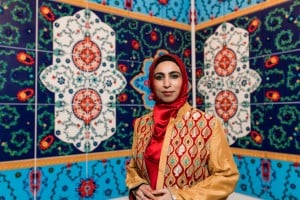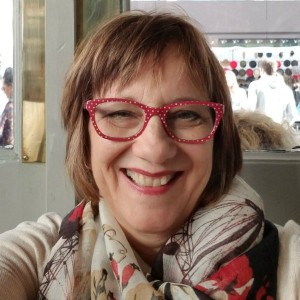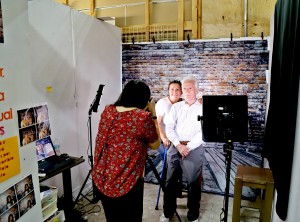A Look Back At Artists In The Spotlight
ArtandSeek.net December 28, 2017 38Every week, we here at Art&Seek highlight the personal journey of a North Texas creative. Today, Anne Bothwell asked me and Jerome Weeks to reflect on who we talked to – and what we learned – this year in the Artist Spotlight.
Hady, you guys really get to go to some amazing and interesting places to report these Spotlight features. Can you tell us about the interesting ones you visited this year?
Hady: Definitely! This year I was in the studio with music producer Sikwitit and rapper Bobby Sessions. I spent time in a flea market bazaar talking with Latino immigrant families for a photo series being crafted by Marcela Reyes. And I also walked through the world’s longest haunted house to learn a bit more about a photo exhibition by Misty Keasler.
And I bet you weren’t scared one bit. Were you?
Hady: I’d prefer you didn’t talk with our intern about how many times I screamed.
Can you top that, Jerome?
Jerome: Yes. I think I can. This year, I went to a tiny, ancient mountain village in Sicily. I followed three Dallas painters who’d been flown there to create murals. It’s part of plan to generate more interest in the town, help keep its people from leaving. And it was really just amazing. The food, the people, everything.
But then, here in town, I went backstage to videotape theater artist Coy Covington as he transformed into women’s attire – dressed in drag – for a major role.
You both get to speak to so many artists and in such wild places, but I’m curious about what you have learned this year?

Ambreen Butt in her exhibition, “I Am All What Is Left Of Me” at Dallas Contemporary. Photo: Yesi Fortuna.
Hady: One of the biggest things I learned this year – and perhaps I should’ve already known it – is that passionate people will use their passion to drive them down amazing paths.
One example that sticks out is painter Ambreen Butt. Butt was born in Pakistan and studied traditional Indian and Persian miniature painting in Lahore. She sort of broke from regional traditions by opting to leave home and study art. Beyond that, she left her country and moved to Boston. While in Boston, she made a name for herself and became part of a crew of young South Asian artists who were rethinking what miniature painting could be. Her work can sometimes be more structural like a sculpture or installation art. It’s amazing. And it’s just so inspirational to see how far (literally) one’s passion can take them.
How about you, Jerome? Anything learned worth noting?
Jerome: Actually, it’s something similar to Hady’s takeaway. I’m still struck by how hard it is to maintain a career in the arts. You need that passion. I mean, forget the rehearsals or studio work. Simply scheduling your life is difficult. You’re constantly negotiating time, because a lot of these people work “day jobs.”
It’s an exhausting career to maintain.
That’s what you learned. But what surprised you?
 Jerome: What surprised me is that you could write off living in England – FOR MONTHS – as a business expense. That’s what mystery novelist Deborah Crombie does. Here’s what she told me:
Jerome: What surprised me is that you could write off living in England – FOR MONTHS – as a business expense. That’s what mystery novelist Deborah Crombie does. Here’s what she told me:
“When I wrote that first book, my idea was that I would have these detectives in England and I would just do the research and it would be tax deductible. And now I think to myself, ‘How was I so smart?!?’”
Hady, so many of the artists that you profiled this year were working on projects that in some way address race and identity issues.
Hady: That’s totally true. But I honestly didn’t even see that connection until you pointed it out. Thanks, Anne.
Anyway, earlier I mentioned hanging out in bazaars with immigrant families and that’s a perfect example. But I also talked with artists making work about the “black experience” and the Latino American experience. The one that sticks out is my feature on the artist duo Tierra Firme. They’re two women from different parts of the Mexico/Texas border. They create artwork using found materials and they’re dead set on creating artwork that makes you think about the phrase “Mexican Art.” Here’s what Sarita Westrup – one half of the duo – told me:
“We work to provide something that you didn’t notice about that area. We’re trying to show this nuance, this layered idea of what a Mexican-American region can be like.”
Jerome, you and I have been talking about how our definition of what an artist is has expanded because of the work we’ve done working on the ‘Artist Spotlight’ series. Can you talk about what that means?
Jerome: Yea. And I think it’s actually really important, because we need to expand our frame of thought when it comes to defining who is or isn’t a cultural worker.
We’ve gone beyond the typical actors, musicians and painters. Hady’s profiled podcasters and a food stylist. I’ve done a painting conservationist and a voice coach. These people are working artists, pieces of the whole industry – shows wouldn’t happen, exhibitions wouldn’t go up without them. They enrich our cultural life.
Guys, we ask all of the artists we profile a set of questions. The idea was to try and find some sort of pattern or try and discover similarities between crafts. And Jerome, you said you noticed something recently about the question ‘Are you creatively satisfied?’ What have you seen?
Jerome: Well, overwhelmingly all I had heard from artists was, ‘No! Never!’ They’re all perfectionist. And they say things like, ‘I’m going to keep doing this until I get it right!’ But then this year, boom! I’ve had three in a row say, ‘Yes.’ And they all said the same things, ‘I love my work, I couldn’t imagine doing anything else, I feel lucky to be doing this.’
Hady: I too have been getting a lot more ‘yes’ answers than ‘no’ answers recently. But they do tend to sound like they’re leaning toward a ‘no.’ And I say that, because their response sounds like this: “Yes! But I want to be doing more!”











